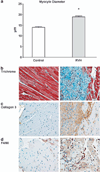Non-invasive assessment of cardiac function in a mouse model of renovascular hypertension
- PMID: 23676847
- PMCID: PMC3928600
- DOI: 10.1038/hr.2013.43
Non-invasive assessment of cardiac function in a mouse model of renovascular hypertension
Abstract
Hypertension continues to be a significant cause of morbidity and mortality, underscoring the need to better understand its early effects on the myocardium. The aim of this study is to determine the feasibility of in vivo longitudinal assessment of cardiac function, particularly diastolic function, in a mouse model of renovascular hypertension. Renovascular hypertension (RVH) was induced in 129S1/SvImJ male mice (n=9). To assess left ventricular (LV) systolic and diastolic function, M-mode echocardiography, pulsed-wave Doppler echocardiography and tissue Doppler imaging were performed at baseline, 2 and 4 weeks after the induction of renal artery stenosis. Myocardial tissue was collected to assess cellular morphology, fibrosis, extracellular matrix remodeling and inflammation ex vivo. RVH led to a significant increase in systolic blood pressure after 2 and 4 weeks (baseline: 99.26±1.09 mm Hg; 2 weeks: 140.90±7.64 mm Hg; 4 weeks: 147.52±5.91 mm Hg, P<0.05), resulting in a significant decrease in LV end-diastolic volume, associated with a significant elevation in ejection fraction and preserved cardiac output. Furthermore, the animals developed an abnormal diastolic function profile, with a shortening in the E velocity deceleration time as well as increases in the E/e' and the E/A ratio. The ex vivo analysis revealed a significant increase in myocyte size and deposition of extracellular matrix. Non-invasive high-resolution ultrasonography allowed assessment of the diastolic function profile in a small animal model of renovascular hypertension.
Figures





Similar articles
-
Type 1 diabetic cardiomyopathy in the Akita (Ins2WT/C96Y) mouse model is characterized by lipotoxicity and diastolic dysfunction with preserved systolic function.Am J Physiol Heart Circ Physiol. 2009 Dec;297(6):H2096-108. doi: 10.1152/ajpheart.00452.2009. Epub 2009 Oct 2. Am J Physiol Heart Circ Physiol. 2009. PMID: 19801494
-
[Analysis of mitral annulus excursion with tissue Doppler echocardiography (tissue Doppler echocardiography = TDE). Noninvasive assessment of left ventricular, diastolic dysfunction].Z Kardiol. 1999 May;88(5):353-62. doi: 10.1007/s003920050297. Z Kardiol. 1999. PMID: 10413858 German.
-
Restoration of Mitochondrial Cardiolipin Attenuates Cardiac Damage in Swine Renovascular Hypertension.J Am Heart Assoc. 2016 May 31;5(6):e003118. doi: 10.1161/JAHA.115.003118. J Am Heart Assoc. 2016. PMID: 27247333 Free PMC article.
-
Clinical aspects of left ventricular diastolic function assessed by Doppler echocardiography following acute myocardial infarction.Dan Med Bull. 2001 Nov;48(4):199-210. Dan Med Bull. 2001. PMID: 11767125 Review.
-
Clinical Impact of Left Ventricular Diastolic Dysfunction in Chronic Kidney Disease.Contrib Nephrol. 2018;195:81-91. doi: 10.1159/000486938. Epub 2018 May 7. Contrib Nephrol. 2018. PMID: 29734153 Review.
Cited by
-
Endothelial glycocalyx is damaged in diabetic cardiomyopathy: angiopoietin 1 restores glycocalyx and improves diastolic function in mice.Diabetologia. 2022 May;65(5):879-894. doi: 10.1007/s00125-022-05650-4. Epub 2022 Feb 25. Diabetologia. 2022. PMID: 35211778 Free PMC article.
-
Echocardiographic Assessment of Cardiac Function in Mouse Models of Heart Disease.Int J Mol Sci. 2025 Jun 22;26(13):5995. doi: 10.3390/ijms26135995. Int J Mol Sci. 2025. PMID: 40649774 Free PMC article. Review.
-
BmooMPα-I, a Metalloproteinase Isolated from Bothrops moojeni Venom, Reduces Blood Pressure, Reverses Left Ventricular Remodeling and Improves Cardiac Electrical Conduction in Rats with Renovascular Hypertension.Toxins (Basel). 2022 Nov 5;14(11):766. doi: 10.3390/toxins14110766. Toxins (Basel). 2022. PMID: 36356016 Free PMC article.
-
Diagnostic ultrasound imaging of mouse diaphragm function.J Vis Exp. 2014 Apr 21;(86):51290. doi: 10.3791/51290. J Vis Exp. 2014. PMID: 24797270 Free PMC article.
References
-
- Roger VL, Go AS, Lloyd-Jones DM, Benjamin EJ, Berry JD, Borden WB, Bravata DM, Dai S, Ford ES, Fox CS, Fullerton HJ, Gillespie C, Hailpern SM, Heit JA, Howard VJ, Kissela BM, Kittner SJ, Lackland DT, Lichtman JH, Lisabeth LD, Makuc DM, Marcus GM, Marelli A, Matchar DB, Moy CS, Mozaffarian D, Mussolino ME, Nichol G, Paynter NP, Soliman EZ, Sorlie PD, Sotoodehnia N, Turan TN, Virani SS, Wong ND, Woo D. Turner MBAmerican Heart Association Statistics C, Stroke Statistics S. Heart disease and stroke statistics—2012 update: a report from the American Heart Association. Circulation. 2012;125:e2–e220. - PMC - PubMed
-
- Brilla CG. Regression of myocardial fibrosis in hypertensive heart disease: diverse effects of various antihypertensive drugs. Cardiovasc Res. 2000;46:324–331. - PubMed
-
- Brilla CG, Funck RC, Rupp H. Lisinopril-mediated regression of myocardial fibrosis in patients with hypertensive heart disease. Circulation. 2000;102:1388–1393. - PubMed
-
- Brilla CG, Janicki JS, Weber KT. Cardioreparative effects of lisinopril in rats with genetic hypertension and left ventricular hypertrophy. Circulation. 1991;83:1771–1779. - PubMed
Publication types
MeSH terms
Grants and funding
LinkOut - more resources
Full Text Sources
Other Literature Sources
